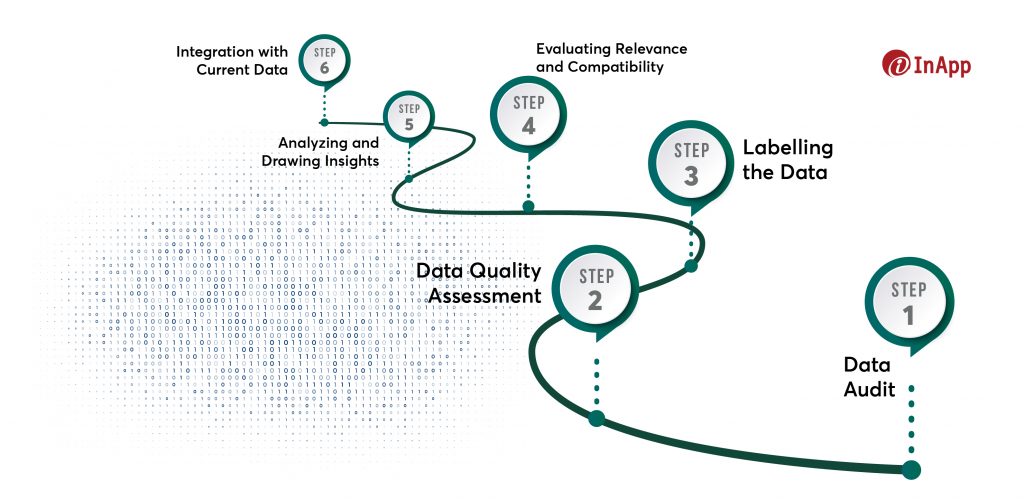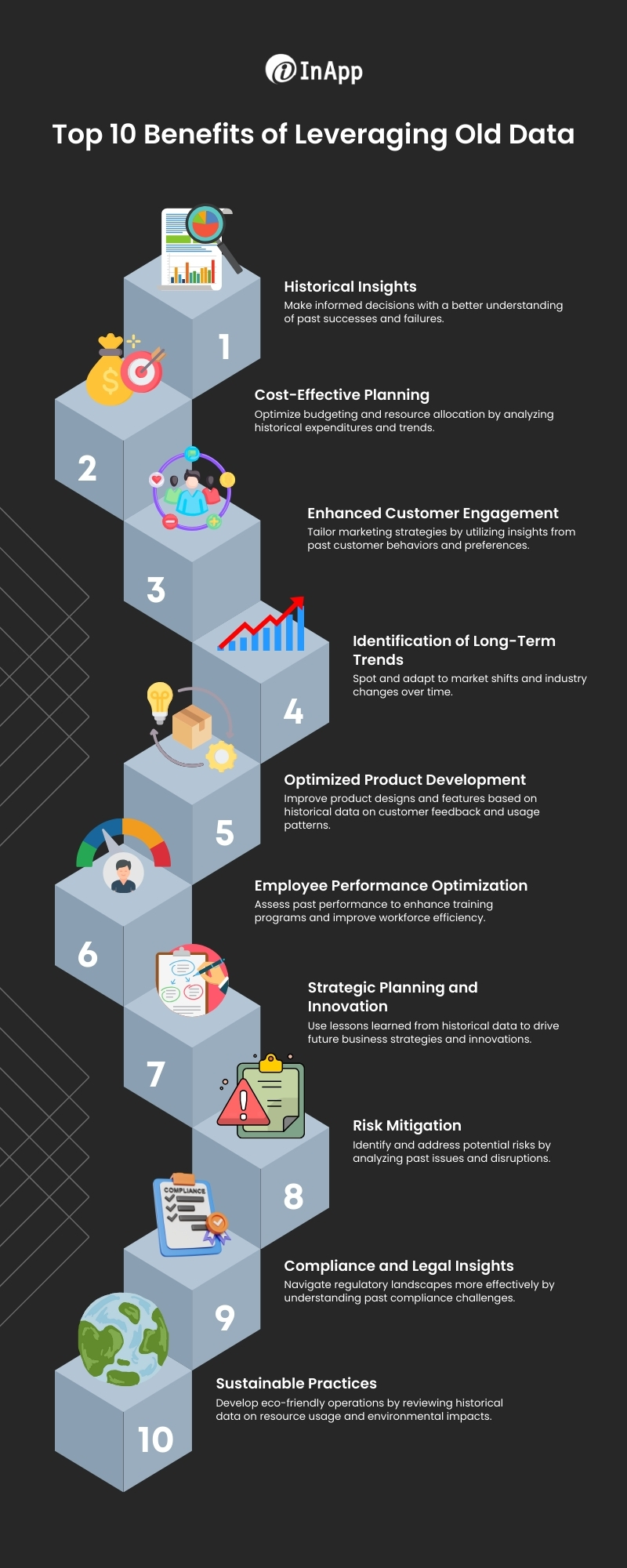Ever wondered what happens to all that old data your company collects? You might be surprised to find out it’s a gold mine waiting to be explored. In the race for the latest tech, companies often overlook the potential tucked away in their archives.
But here’s the scoop: those forgotten customer records, past trends, and buried feedback can be the secret sauce for smarter decisions.
We are surrounded by data but starved for insights
Jay Baer, Marketing and Customer Experience Expert
Unearthing this historical data goldmine isn’t just about nostalgia—it’s about leveraging past insights for future success. In the hidden corners of old data, businesses find the keys to strategic planning, sustainability, compliance, and cost reduction.
In this blog, we will discuss how to turn your old data into your business’s secret weapon. Get ready to dig into the past and uncover the riches you never knew you had!
Old Data – The Forgotten Treasure Trove
So what is old data?
Old data in business means information a company collects that was super important once but now isn’t in the spotlight. Think old chats with customers, records of what was sold, and how things were run. It’s like a digital scrapbook full of emails, customer files from way back, or even ancient software versions.
This old stuff is like a time machine, letting you peek at how the company has changed. In essence, it encapsulates the digital footprints left by a company’s journey through time, holding valuable insights that, if properly mined, can offer a unique perspective on the evolution of the business.
People often underestimate the power of old data, thinking it’s just taking up space. Some believe it’s irrelevant in our speedy world. But the truth is, these digital archives are like time capsules holding the story of your business. They’re not a burden; they’re a gold mine of insights. Looking back helps us see patterns, and trends, and learn from what worked and what didn’t. It’s not about hoarding data; it’s about smart thinking. When we approach old data with a plan, it becomes a source of wisdom, guiding us to make better decisions.
Reviving the Old Data – A Journey of Resurrection
You’ve uncovered a treasure trove of old data, but before you can use it, it needs a makeover. Reviving old data involves a meticulous process that starts with a data audit—an essential step in understanding and assessing the state of your digital archives.

Step 1: Data Audit
During a data audit, you examine the contents of your historical datasets. This involves identifying the types of data, its sources, and the formats it exists in. Think of it as taking inventory of the digital artifacts that have been tucked away. This step helps you gain a comprehensive overview of what’s available and what might be missing.
Step 2: Data Quality Assessment
Once the audit is complete, it’s time for a data quality assessment. This involves evaluating the accuracy, completeness, and reliability of your old data. For example, if your dataset contains customer information, you’d check for errors, missing details, or outdated entries. If your business conducted surveys in the past, assess the consistency and validity of the responses. Data that doesn’t pass the quality assessment is like clutter— it needs to go.
Step 3: Labelling the Data
After the data quality assessment, it’s crucial to label the data effectively. This involves categorizing it as structured or unstructured. Structured data is neatly organized and follows a predefined format, like a spreadsheet. Unstructured data, on the other hand, lacks a specific format and includes things like emails, documents, or images. Proper labeling allows you to understand the nature of your data, making it easier to manage and analyze.
Step 4: Evaluating Relevance and Compatibility
With a clean, labeled dataset in hand, the final step is evaluating its relevance and compatibility with your current goals. Ask yourself: Is the information still pertinent? Does it align with current company standards? Can it be seamlessly integrated with your existing data?
If so, consider what changes or conversions may be necessary for a smooth merger. This process ensures that the revived data not only contributes to your current objectives but also aligns seamlessly with your present data infrastructure.
Step 5: Analyzing and Drawing Insights
With a clean and labeled dataset, it’s time for the exciting part—analysis. This step involves using various tools and techniques to explore patterns, trends, and hidden gems within the data. For example, if you have historical customer purchase records, you can analyze buying patterns to predict future behavior. It’s like putting together a puzzle; each piece of data contributes to the bigger picture, revealing insights that can guide decision-making.
Step 6: Integration with Current Data
To maximize the value of your insights, it’s crucial to integrate the old data with your current datasets. This involves evaluating whether the cleaned-up data is still relevant and compatible with your current goals. Does it align with current company standards? Can it seamlessly merge with your existing data? If adjustments are needed, they are made during this stage to ensure a smooth integration.
In essence, transforming old data into valuable insights is about turning a digital time capsule into a strategic asset. It’s not just about looking back; it’s about leveraging historical information to make informed decisions in the present and shape a successful future.
What Are the Benefits of Leveraging Old Data?
Leveraging old data can offer countless benefits for businesses willing to delve into their historical archives. Here’s a glimpse into the advantages of tapping into this often-overlooked resource:

- Historical Insights for Informed Decision-Making
Old data provides a historical perspective, offering insights into past successes and failures. Analyzing historical patterns and trends equips businesses with valuable information for making informed decisions in the present and future.
- Cost-Effective Planning
By leveraging old data, businesses can optimize resource allocation and streamline operations. Understanding past expenditures, market conditions, and customer behaviors allows for more accurate financial forecasting and budget planning.
- Enhanced Customer Engagement:
Old data contains a wealth of information about customer preferences, interactions, and purchasing behaviors. By tapping into this historical customer data, businesses can tailor their marketing strategies, enhance customer engagement, and foster long-term relationships.
- Identification of Long-Term Trends
Examining historical market trends and industry shifts can help businesses identify long-term patterns. This foresight enables proactive adjustments to strategies, ensuring adaptability to changing market conditions.
- Optimized Product Development
Historical data provides insights into the success or shortcomings of past products and services. Businesses can use this information to optimize current and future product development, addressing customer needs based on historical preferences.
- Employee Performance Optimization
Analyzing historical employee data aids in evaluating performance, identifying training needs, and optimizing workforce management. It enables businesses to recognize and nurture talent while addressing areas that may need improvement.
- Strategic Planning and Innovation
Old data serves as a foundation for strategic planning. By understanding the historical context of the business, organizations can foster innovation and avoid repeating past mistakes, ensuring a forward-looking approach.
- Risk Mitigation
Historical data helps businesses anticipate and mitigate risks by understanding past challenges and disruptions. This proactive approach to risk management enhances the resilience of the organization in the face of unforeseen circumstances.
- Compliance and Legal Insights
Examining historical compliance data provides insights into past regulatory challenges and changes. This understanding is crucial for maintaining compliance, adapting to evolving regulations, and avoiding legal pitfalls.
- Sustainable Practices
For industries with environmental considerations, historical data on resource usage and environmental impact guides the development of sustainable practices, aligning business operations with ecological responsibility.
To Sum Up – Unlocking Insights from the Past
As we close the chapter on the untapped potential within your old data, remember that beneath the digital dust lie insights that can reshape your business strategies, fortify customer connections, and streamline operations. By tapping into the wealth of information buried in your archives, you gain a competitive edge—insights that illuminate trends, inform decisions, and fuel innovation.
Now, it’s your turn. Dig into your data archives. Seize this opportunity for informed decision-making and lasting success. If you need help, reach out to us and we will guide you through the process of mining your historical data for actionable insights.
Remember, embracing old data isn’t just for today; it’s a strategic move for the future. As technology evolves, the lessons from historical data become priceless. Companies leveraging their past are better equipped to navigate challenges, innovate, and ensure long-term growth. In the era of big data, unlocking yesterday’s insights is the key to tomorrow’s success.
